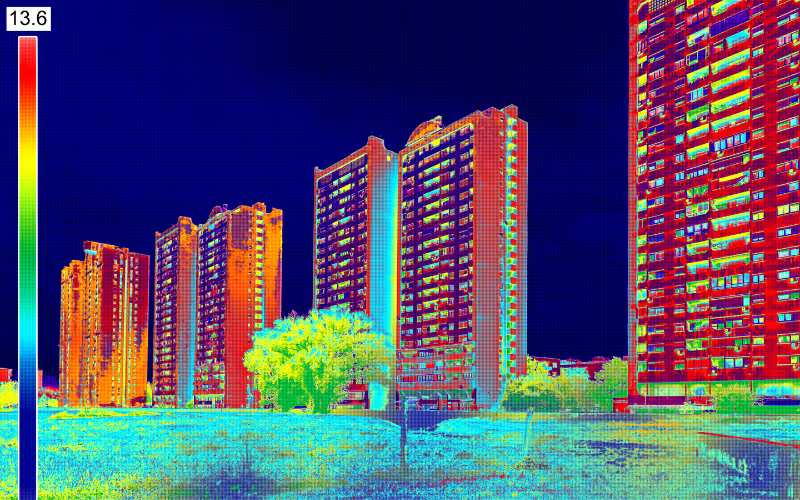
See the Unseen: Common Issues Detected with Thermal Imaging
The world around us is filled with hidden information, which can often be revealed by temperature variations that are invisible to the naked eye. Thermal imaging technology steps in, acting as a powerful tool to reveal these anomalies. By translating heat signatures into visual images and providing precise temperature value readings, thermal cameras offer a unique perspective, uncovering a wide range of issues across various industries. In this blog post, we'll delve into some of the most common problems that can be identified using thermal imaging technology.
Optimizing Industrial Processes
In the industrial sector, thermal imaging plays a vital role in optimizing processes and ensuring smooth operations. Thermal cameras can identify overheating components in machines before they fail, allowing for predictive maintenance and avoiding costly breakdowns. This is particularly valuable in production lines, where stopping a machine can significantly disrupt operations and impact production targets. In addition to supporting machinery health, thermal imaging can reveal uneven temperature patterns in industrial processes, helping to identify inefficiencies and optimize production.
Keeping Buildings Safe and Efficient
Thermal imaging plays a crucial role in ensuring the safety and efficiency of our buildings. It excels at pinpointing electrical faults, such as loose or corroded connections, overloaded circuits, and overheating components—all of which are potential fire hazards. Detecting these issues early allows for timely repairs that can prevent costly damage and ensure the safety of the building’s occupants.
Thermal cameras can also expose issues and anomalies in a building's envelope—the physical barrier between the conditioned interior and the outside environment. As one example, this can help identify areas where heating or cooling energy is escaping through inadequate insulation. By revealing these hidden inefficiencies, thermal imaging empowers building owners and managers to take corrective actions to increase energy efficiency and lower utility bills. Additionally, hidden leaks in plumbing systems can cause significant water damage and pose health risks. Thermal imaging's ability to detect the temperature difference between wet and dry areas proves invaluable in locating leaks behind walls, floors, or even underground.
Thermal Imaging: A Powerful Tool for Diverse Industries
The applications of thermal imaging extend far beyond traditional industries. Here are a few additional areas where this technology offers significant benefits:
Predictive maintenance in renewable energy: Thermal cameras can be used to inspect solar panels for defects or hotspots that could impact efficiency. Similarly, they can identify potential issues in wind turbines, allowing for proactive maintenance and ensuring optimal energy production.
Quality control in manufacturing: Thermal cameras can be used to identify defects in products during the manufacturing process. For instance, they can detect inconsistencies in temperature distribution on castings, potentially revealing flaws that would otherwise go unnoticed until later stages and require costly rework.
Data center efficiency: Thermal imaging can be a valuable tool in data centers, helping identify hotspots in servers and other equipment. By proactively addressing these issues, data center operators can ensure optimal performance and minimize energy consumption.
Facility management: Thermal imaging can be a valuable tool for facility managers, helping them identify potential problems with HVAC systems, locate missing insulation in pipes, and even detect rodent activity within buildings.
Beyond these applications, thermal imaging has a surprisingly wide range of uses such as pest control (detecting animal activity), building security (identifying intruders), and even archaeology (discovering buried structures).
Quality Control with Thermal Imaging
Thermal imaging has become an indispensable tool for ensuring product quality and process consistency in manufacturing environments susceptible to temperature variations. Unlike traditional inspection methods that rely on visual cues or physical contact, thermal imaging offers a non-destructive and quantitative approach to quality control.
By capturing and analyzing thermal signatures, manufacturers gain valuable insights into temperature distributions across their products and processes. This enables them to:
Verify product quality: Thermal imaging can detect even minute temperature variations that might indicate defects related to uneven heating or cooling. This allows manufacturers to ensure their products meet specific temperature requirements and avoid potential failures.
Enhance process consistency: Thermal cameras can reveal subtle variations in temperature patterns across a production line. These variations might signal inconsistencies in the manufacturing process, such as improper heating or cooling settings. By identifying these inconsistencies early on, manufacturers can take corrective actions to reduce defects and minimize waste.
Inspection Services
To fully harness the potential of thermal imaging, consider hiring qualified and trained professionals to perform inspection services. MSAI Inspection Services offers expertise in leveraging thermal imaging technology to identify potential issues and optimize operations.
Professional inspection services enhance asset reliability by helping detect problems early, allowing for preventive maintenance and reducing unexpected failures. These services also help ensure compliance with industry regulations, avoiding penalties and maintaining certifications. Additionally, inspections boost energy efficiency and support data-driven decision-making through detailed analyses, optimizing maintenance and investment strategies.
The Future of Thermal Imaging
As thermal imaging technology continues to evolve, we can expect even more innovative applications to emerge. Integration with artificial intelligence and advanced data analysis will unlock new possibilities for preventive maintenance, remote monitoring, and process optimization across a vast array of industries.
Here at MultiSensor AI (MSAI), our cloud-based solutions harness the power of thermal imaging alongside advanced sensor data and AI analysis to create comprehensive solutions. MSAI Connect empowers users with real-time insights, enabling them to proactively address potential issues and optimize operations.
Thermal imaging is a powerful tool with immense potential. By leveraging this technology alongside other advanced sensors and AI analysis, even more comprehensive solutions can be created for a wide range of challenges. Explore our blog to learn more about how AI-powered thermal imaging solutions can help you see the unseen and achieve new levels of efficiency and safety.


-1.png?width=1200&height=1200&name=UK%20Condition%20Monitoring%20(Blog%20Post)-1.png)